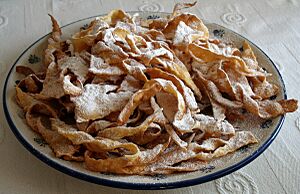Fat Thursday facts for kids
Quick facts for kids Fat Thursday |
|
|---|---|

Plate of Polish pączki
|
|
| Type | Christian, cultural |
| Significance | Celebration period before fasting season of Lent |
| Celebrations | Feasting |
| Date | 5 days before Shrove Tuesday and Mardi Gras, 6 days before Ash Wednesday, 52 days before Easter |
| 2024 date | February 8 |
| 2025 date | February 27 |
| 2026 date | February 12 |
| 2027 date | February 4 |
| Frequency | Annual |
| Related to | Carnival, Fat Tuesday |
Fat Thursday is a special day in some countries. It is the last Thursday before Lent. Lent is a time when some people fast or give up certain foods. Fat Thursday is part of the Carnival celebrations. It is a chance to enjoy lots of delicious food before the fasting period begins. People often meet with friends and family. They eat many sweets, cakes, and other tasty meals. These foods are usually not eaten during Lent. Popular treats include pączki (donuts) in Poland. Another favorite is Berliners, which are donuts filled with jam. People also enjoy angel wings (faworki), which are crispy pastries with powdered sugar.
Contents
Fat Thursday Around the World
France's Crepes
In France, Fat Thursday is called Jeudi Gras. This means "Fat Thursday" in French. On this day, people often make crepes. Crepes are thin pancakes. They use up butter, lard, and eggs that might not be eaten during Lent. This tradition is similar to how people in England make pancakes on Shrove Tuesday.
German Carnival Fun
In Germany, especially in the Rhineland, Fat Thursday is known as Weiberfastnacht. This is an unofficial holiday. Many workplaces close early, often before noon. The celebrations start at 11:11 am. People wear fun costumes. They celebrate in pubs and in the streets. There are not many big parades like on Rosenmontag.
A special tradition happens in Beuel, a part of Bonn. Women there have celebrated their own "carnival committee" since 1824. They symbolically "storm" the town hall. This event is even shown live on TV! In many towns, women take over the town halls. A fun custom is that women cut off men's ties. Ties are seen as a symbol of men's status. In return, the men get a Bützchen, which is a little kiss.
Greece's Smoky Thursday
In Greece, Fat Thursday is called Tsiknopempti. This name means "Smoky Thursday" or "Charred Thursday." It is part of the Greek Carnival season, called Apókries. The main idea of this day is to eat lots of grilled and roasted meats. It's a big feast of meaty dishes.
Italy's Festive Celebrations
Italy celebrates Giovedì grasso, or Fat Thursday. It is quite similar to martedì grasso (Shrove Tuesday). In Venice around 1900, this day was very lively. There were masquerade parties where people wore masks. A "battle of flowers" took place in the main square. The city was lit up with lights. It was a day filled with fun and excitement. An old writer, Marie Corelli, described it as a day when "the fooling and the mumming, the dancing, shrieking, and screaming would be at its height."
Netherlands' Role Reversal
In the Netherlands, there is a tradition similar to Germany's Weiberfastnacht. On the Thursday before Carnival, women sometimes wear men's clothes. This is a way of "reversing roles." It's like they are playfully "being the man" for the day. This tradition has been known in Cologne since 1824.
Poland's Sweet Treats

In Poland, Fat Thursday is called tłusty czwartek. This means "Fat Thursday" in Polish. People go to their local bakeries to buy their favorite pastries. The most traditional food is pączki. These are large, deep-fried donuts. They are usually filled with fruit jam or rose petal jam. Then they are topped with powdered sugar, icing, or glaze. Another popular treat on this day is angel wings. These are called faworki or chrusty in Polish. They are light, crispy pastries.
Slovenia's Delicious Doughnuts
In Slovenia, Fat Thursday has its own special food traditions. People enjoy rich and hearty foods. A very common treat is krof. This is a type of doughnut. It is usually filled with jam, especially apricot jam. Then it is dusted with powdered sugar. These doughnuts are a main part of the celebration. Besides krof, other rich foods are eaten. This shows the tradition of enjoying food before Lent. It is also a time for friends and family to gather. There are often community events with music and festivities.
Spain's Special Pastries
In Spain, this day is called jueves lardero or jueves de comadre. In areas where Catalan is spoken, it is called dijous gras. It is often seen as a children's holiday. In Albacete, Spain, people celebrate jueves lardero or Dia de la Mona. They eat a round pastry called mona. It has a boiled egg in the middle. In Aragon, people prepare a meal with a special sausage from Graus. In Catalonia, the tradition is to eat sweet Bunyols (fritters) and Botifarra d’ou (a type of sausage).
Other Traditions
Some Syrian Catholics celebrate this day as "Drunkard's Thursday." Their traditional food for the day is dolmas. These are often stuffed grape leaves.
See also
 In Spanish: Jueves lardero para niños
In Spanish: Jueves lardero para niños
- Mardi Gras
- Maslenitsa (a similar holiday in Russia)
- Shrove Tuesday
- Tsiknopempti


